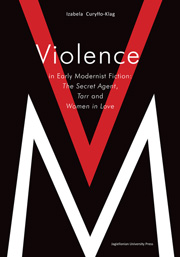Book contents
- Frontmatter
- Contents
- Acknowledgements
- Introduction
- CHAPTER I Modernist Consciousness of Crisis and the Emergent Violence Mythos
- CHAPTER II Ticking Towards Disaster—Violence as “The Enemy Within” in Conrad's The Secret Agent
- CHAPTER III “All Personality Was Catching”—Mimetic Rivalry and the Contagion of Violence in Tarr
- CHAPTER IV Humanity in a Cul-de-sac: Women in Love as an Epic of Sacrificial Crisis
- Conclusion
- Bibliography
CHAPTER IV - Humanity in a Cul-de-sac: Women in Love as an Epic of Sacrificial Crisis
Published online by Cambridge University Press: 05 September 2014
- Frontmatter
- Contents
- Acknowledgements
- Introduction
- CHAPTER I Modernist Consciousness of Crisis and the Emergent Violence Mythos
- CHAPTER II Ticking Towards Disaster—Violence as “The Enemy Within” in Conrad's The Secret Agent
- CHAPTER III “All Personality Was Catching”—Mimetic Rivalry and the Contagion of Violence in Tarr
- CHAPTER IV Humanity in a Cul-de-sac: Women in Love as an Epic of Sacrificial Crisis
- Conclusion
- Bibliography
Summary
The last century [the 19th] was the winter of the West, the victory of materialism and scepticism, of socialism, parliamentarianism, and money. But in this century blood and instinct will regain their rights against the power of money and intellect. The era of individualism, liberalism and democracy, of humanitarianism and freedom, is nearing its end. The masses will accept with resignation the victory of the Caesars, the strong men, and will obey them.
Oswald Spengler, Decline of the WestIn the year when Wyndham Lewis went to the Front, D.H. Lawrence completed Women in Love. Although originally conceived as a sequel to The Rainbow, the novel proved quite different in mood from anything Lawrence had produced before: revising it, he doubted the possibility of ever finding a publisher for such a gloomy, “end-of-the-world” narrative. While his previous work seemed to him “destructive-consummating,” the new creation was “purely destructive” and, in its vision of a declining civilisation, poignantly resonant of the war Zeitgeist. Always interested in man's inherent darkness but perhaps more than other modernists inclined to value it as a creative force, Lawrence found himself grievously affected by the developments of contemporary history. The war shook his faith in human capacity for spiritual rebirth through crisis, and, as he made clear in one of his letters, the transition from The Rainbow to Women in Love reflects this change of perspective:
About The Rainbow: it was all written before the war, though revised during Sept. and Oct. 1914.
- Type
- Chapter
- Information
- Violence in Early Modernist FictionThe Secret Agent, Tarr and Women in Love, pp. 89 - 111Publisher: Jagiellonian University PressPrint publication year: 2011



